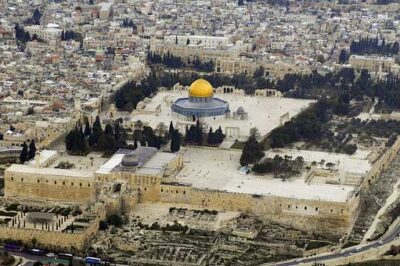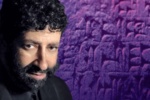The Jewish connection to the Temple Mount as a sacred Jewish holy site has existed since ancient times.
The Jewish people have a historical, religious, spiritual and national connection to the Temple Mount area dating back to antiquity. For the Jewish people, it is the holiest site on the entire planet.
It was the location of the creation of Adam, the binding of Isaac, as well as both the First and Second Temples. When the Jewish Temple existed, all Jews used to visit there to perform sacrifices to G-d three times per year, as commanded by G-d. It was the sacred building that housed the Ark of the Covenant in which the Ten Commandments were stored.
Archaeological treasures found there demonstrate that a Jewish Temple used to exist on the Temple Mount. While the Islamic Waqf has attempted to destroy such evidence, Israeli archaeologists have been able to rescue some of it, such as a fragment from a Herodian-style, Second-Temple-era sculptured stone that used to stand on the Temple Mount; a Babylonian arrowhead attesting to the destruction of the First Temple; and the seal of a First-Temple-era priestly family.
The Western Wall also still stands today as a visual reminder that a Jewish Temple used to exist on the Temple Mount.
Despite Palestinian Authority claims that no Jewish connection existed, many Muslim religious sources throughout history have accepted the Jewish connection to the Temple Mount area. According to the Global Research in International Affairs (GLORIA), “In Sura 17:1 of the Quran, the ‘Farthest Mosque’ is called the al-masjid al-Aqsa. The Tafsir al-Jalalayn, a well-respected Sunni exegesis of the Quran from the 15th and 16th centuries, notes that the ‘Farthest Mosque’ is a reference to the Bayt al-Maqdis of Jerusalem. In Hebrew, the Jewish Temple is often referred to as the Beyt Ha-Miqdash, nearly identical to the Arabic term.”
Furthermore, GLORIA notes, “In the commentary of Abdullah Ibn Omar al-Baydawi, who authored several prominent theological works in the 13th century, the masjid is referred to as the Bayt al-Maqdis because, during Muhammad’s time, no mosque existed in Jerusalem. Quranic historian and commentator Abu Jafar Muhammad al-Tabari, who chronicled the seventh century Muslim conquest of Jerusalem, wrote that one day when Umar finished praying, he went to the place where ‘the Romans buried the Temple (bayt al-maqdis) at the time of the sons of Israel.’”
Even upon the destruction of the Jewish Temple, Jews have continued to journey to the Temple Mount area in order to weep over the destruction of their holy site. According to the Cairo Genizah, following the Arab conquest of Jerusalem in the seventh century, 70 Jewish families relocated to Jerusalem and lived very close to the Temple Mount. The Cairo Genizah claimed that they established a synagogue in Warren’s Gate, that wealthy Jews used to contribute money to pay for the upkeep of the Warren’s Gate synagogue, and many Jews used to go on pilgrimages to the holy site until the Warren’s Gate synagogue was destroyed during the First Crusade.
Yet even following the destruction of the Warren’s Gate synagogue, Jews continued to travel to the Temple Mount to pray. One medieval Jew, Nachmanides, wrote shortly after making Aliyah to Eretz Yisrael around 1263, “But the loss of all this and of every other glory my eyes saw is compensated by having now the joy of being a day in thy courts, O Jerusalem, visiting the ruins of the Temple, and crying over the desolate sanctuary.”
In modern times, many Jews travel to the Western Wall, otherwise known as the Kotel, to pray and place a note to G-d inside the cracks of this ancient wall. According to Abraham Lincoln’s secretary of state, William Seward, Jews were praying at the Western Wall well before the rise of modern Zionism.
For the original article, visit unitedwithisrael.org.








Leave a Comment
You must be logged in to post a comment.